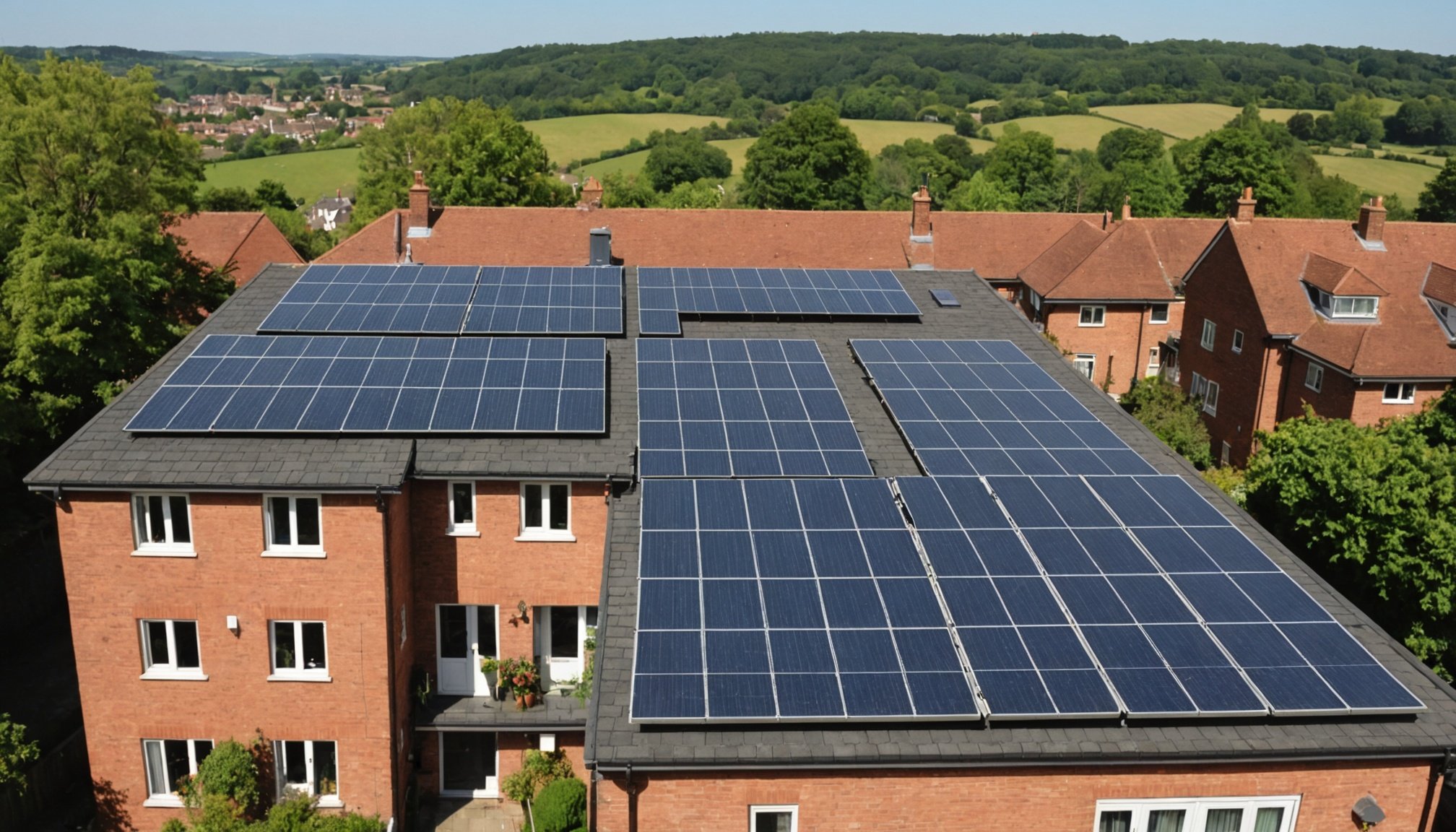Introduction to Solar Efficiency on Terraced Roofs
Solar efficiency plays a crucial role in the decision for homeowners considering renewable energy solutions. The benefits of harnessing solar energy are undeniable, providing both environmental advantages and cost savings on energy bills. However, when it comes to terraced roofs, maximizing the efficiency of solar panels becomes a vital task that requires thoughtful planning.
One of the key elements to consider is the panel arrangement. Proper alignment and placement optimize exposure to sunlight, significantly boosting solar efficiency. The unique structure of terraced roofs presents distinctive challenges not faced by traditional roof types. These could include varying slopes, different orientations of the roofs, and shared walls with adjacent properties. Each factor must be carefully addressed to ensure the highest energy yield.
Also to see : Top Drought-Resilient Plants Perfect for Your UK Garden
In Reading, like many places, understanding these challenges is key to successful installations. Homeowners and installers must navigate complex spatial constraints while taking advantage of the benefits solar efficiency offers. Tailoring solar solutions for terraced roofs involves innovative and strategic design approaches, which not only enhance energy capture but also harmonize with typical architectural features found in Reading’s residential landscapes.
Factors Influencing Solar Panel Arrangement
Understanding the factors that impact solar panel arrangement on terraced roofs is crucial for maximizing energy efficiency. A primary consideration is the roof slope and direction. Steeper slopes may capture sunlight differently than flatter ones, affecting energy yield. Terraced roofs often vary in orientation, which influences solar panel orientation and necessitates strategic placement to optimize sunlight exposure.
Have you seen this : Fixing method using clips or rails: a practical guide
Another significant factor is the presence of surrounding structures. Buildings, trees, or other features can cast shadows, reducing the effectiveness of installed panels. Recognizing these potential obstructions helps in planning arrangements that avoid or mitigate shading issues.
Furthermore, vegetation and seasonal changes can alter sunlight patterns. Trees may shed leaves during some seasons but could still cast shadows during others. Homeowners should be aware of these changes throughout the year, ensuring that panels receive maximum sunlight regardless of seasonal variations.
Lastly, evaluating the architectural features specific to terraced homes, such as shared walls and varying roof heights, is imperative. Planning should accommodate these elements, potentially addressing them through innovative solar panel orientation strategies to maintain efficiency.
Ideal Angles and Orientations for Solar Panels
To maximize solar efficiency, determining the ideal angles and orientations for solar panels on terraced roofs is essential. The recommended tilt angle typically depends on the latitude of the installation site. For Reading, a tilt angle close to the area’s latitude is often optimal, aligning with the sun’s path for maximum energy capture.
A south-facing orientation is generally favoured as it tends to receive the most consistent sunlight throughout the day, enhancing energy yield. Panels oriented towards the southern direction can often absorb up to 20% more sunlight compared to other directions. However, terraced roofs may require adjustments to accommodate varying orientations and slopes of each section.
Seasonal changes also play a role in panel orientation. Adjusting the tilt angle seasonally can help optimize energy production; lower tilts in summer and steeper in winter can align panels more directly with the sun’s position. For homeowners in Reading, creatively adapting panel placement to suit these solar angles and seasonal shifts ensures consistent and efficient energy production, even when roof orientations are less than ideal. Efforts in aligning solar panels strategically pay off in enhanced solar efficiency.
Local Solar Regulations and Considerations
When planning a solar installation in Reading, understanding local solar regulations is crucial. These regulations ensure installations meet safety and performance standards while blending seamlessly with the town’s unique architectural landscape. Acquiring the necessary installation permits is a critical step. Homeowners must navigate the approval processes, which might include assessments of panel size, placement, and potential impacts on neighbours.
In Reading, specific building codes come into play, particularly concerning terraced roofs. These codes dictate structural integrity requirements and aesthetic guidelines, ensuring that solar panels maintain both the safety of the building and the visual harmony of the neighbourhood. Installers and homeowners alike must adhere to these codes to avoid legal implications and ensure a successful installation.
Additional considerations may include historical preservation rules if the property is in a designated area. It’s wise for homeowners and installers to consult with local authorities or experienced professionals familiar with Reading’s solar guidelines to streamline the process. By fully complying with these solar regulations, homeowners in Reading can confidently pursue their solar energy projects, achieving efficient and legally-sound installations.
Unique Architectural Considerations for Terraced Roofs
Terraced roof features in Reading require thoughtful planning when integrating solar panels. The architectural styles prevalent in the area often include shared walls and limited roof space. These structural elements necessitate customized design considerations to ensure efficient solar panel arrangements.
Adaptation involves aligning solar installations with the existing architecture. For instance, the limited spaces can be utilized more effectively through staggered panel placements that follow the roof’s contours. This approach not only optimizes energy capture but also maintains the building’s aesthetic appeal.
Integration of panels involves balancing functionality with visual harmony. Panels must blend seamlessly with architectural features, such as dormer windows or chimneys, to preserve the dwelling’s historical character. Introducing sleek designs can enhance both energy efficiency and curb appeal.
Moreover, homeowners need to consider terraced roof features like the load-bearing capacity. Understanding this ensures the roof can safely accommodate the additional weight of the panels. Collaborating with architects familiar with Reading’s architectural intricacies can result in designs that accommodate these considerations, creating sustainable energy solutions that meld with existing structures while maximizing solar efficiency.
Case Studies of Successful Solar Installations
Solar installation examples from Reading offer rich insights into effective energy solutions on terraced roofs. These case studies showcase varied approaches and considerations tailored to overcome unique architectural challenges. One particular project demonstrated innovative panel arrangement on a multi-tiered terraced house. By strategically utilizing staggered placements, the homeowners maximised sunlight exposure and optimised energy yield.
The versatility in solar panel orientation was key to a second project’s success. Here, adapting to the varying roof slopes allowed for the integration of different solar angles, crucial for capturing solar rays throughout the day. The design ensured panels aligned with roof contours, preserving the architectural aesthetic.
Lessons from these installations highlight the importance of evaluating shadow effects from surrounding structures. Creatively choosing placements that avoid shading can drastically enhance solar efficiency.
Moreover, projects highlight collaboration with local authorities and compliance with solar regulations as pivotal for smooth processes. By adhering to guidelines and leveraging advanced technologies, these homeowners achieved notable energy savings. Such examples provide valuable insights into sustainable energy solutions for terraced homes, showcasing the practicality and benefits of skilled solar installations.
Cost Implications and Return on Investment
Understanding the solar costs and estimating the ROI is essential for homeowners considering panel installations. Initial expenses encompass purchasing panels, permits, and professional installations. Although this may seem substantial, the long-term financial and energy savings often justify the investment. For instance, a well-planned panel arrangement can maximize energy capture, leading to significant reductions in utility bills over time.
To evaluate potential energy savings, homeowners should conduct a detailed analysis based on their specific roof’s orientation, slope, and location’s solar exposure. This allows for an accurate prediction of efficiency and the subsequent financial benefits. The more sunlight panels receive, the greater the energy yield and subsequent cost benefits.
Assessing the long-term ROI involves accounting for the decrease in energy costs set against the initial setup expenses. Calculating this over a span of 20-25 years, which is the typical lifespan of solar panels, provides a clear picture of the financial gains. Homeowners in Reading should weigh these factors and consider incentives or rebates that may be available to enhance their solar efficiency and ROI. This strategic approach ensures that the investment remains financially sound and rewarding.
Actionable Insights for Homeowners and Installers
When exploring solar installations on terraced roofs, homeowners can start by assessing their roof’s orientation and space to determine solar efficiency potential. Evaluate sunlight exposure throughout the year, taking into account seasonal changes and shadow effects from surrounding buildings or vegetation.
For solar installers, developing an efficient design involves strategic panel arrangement that considers the unique challenges posed by terraced roofs. Analyze each roof section’s slope and direction to optimize panel orientation and sun exposure. Tailoring designs to the specific architectural features common in Reading, such as shared walls and varying roof elevations, is crucial for maximizing energy capture and maintaining aesthetic appeal.
Consistent maintenance and periodic adjustments ensure long-term efficiency. Clean panels regularly and clear debris to sustain maximum sunlight absorption. Reviewing and recalibrating panel angles seasonally can substantially enhance energy yields.
Homeowners benefit from collaborating with experienced professionals who provide insights based on successful local case studies. This partnership aids in navigating Reading’s solar regulations, securing necessary permits, and ensuring compliance with safety and aesthetic codes. Following these strategies strengthens solar efficiency, achieving sustainable and cost-effective energy solutions.











